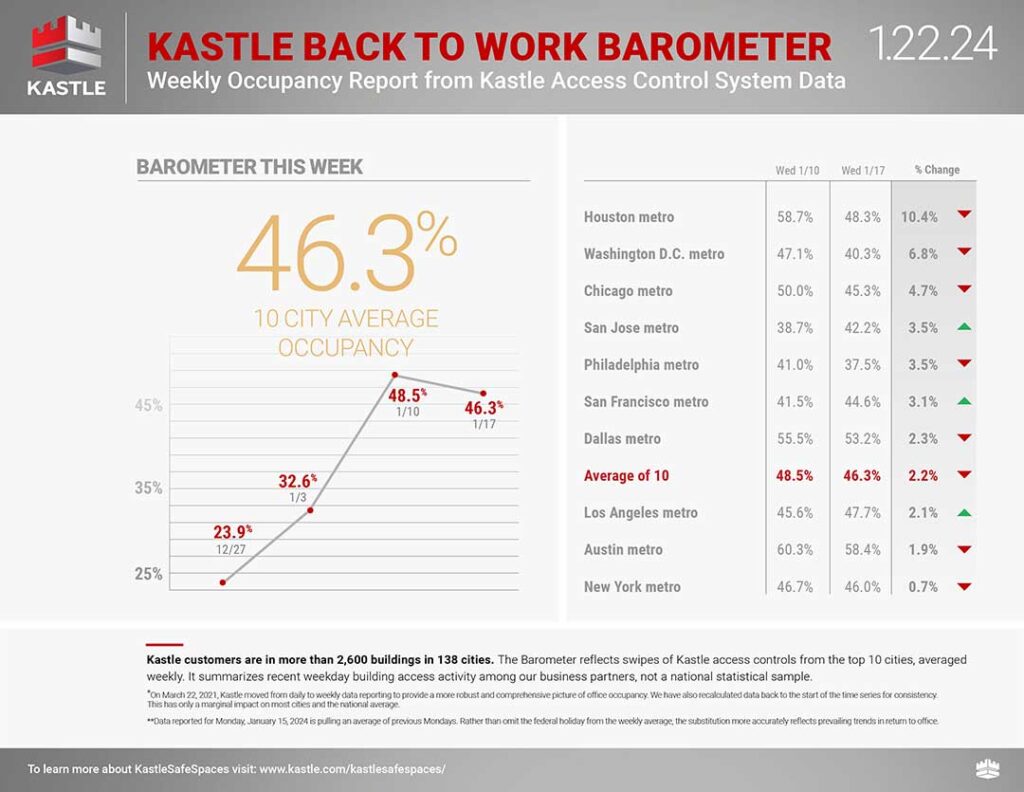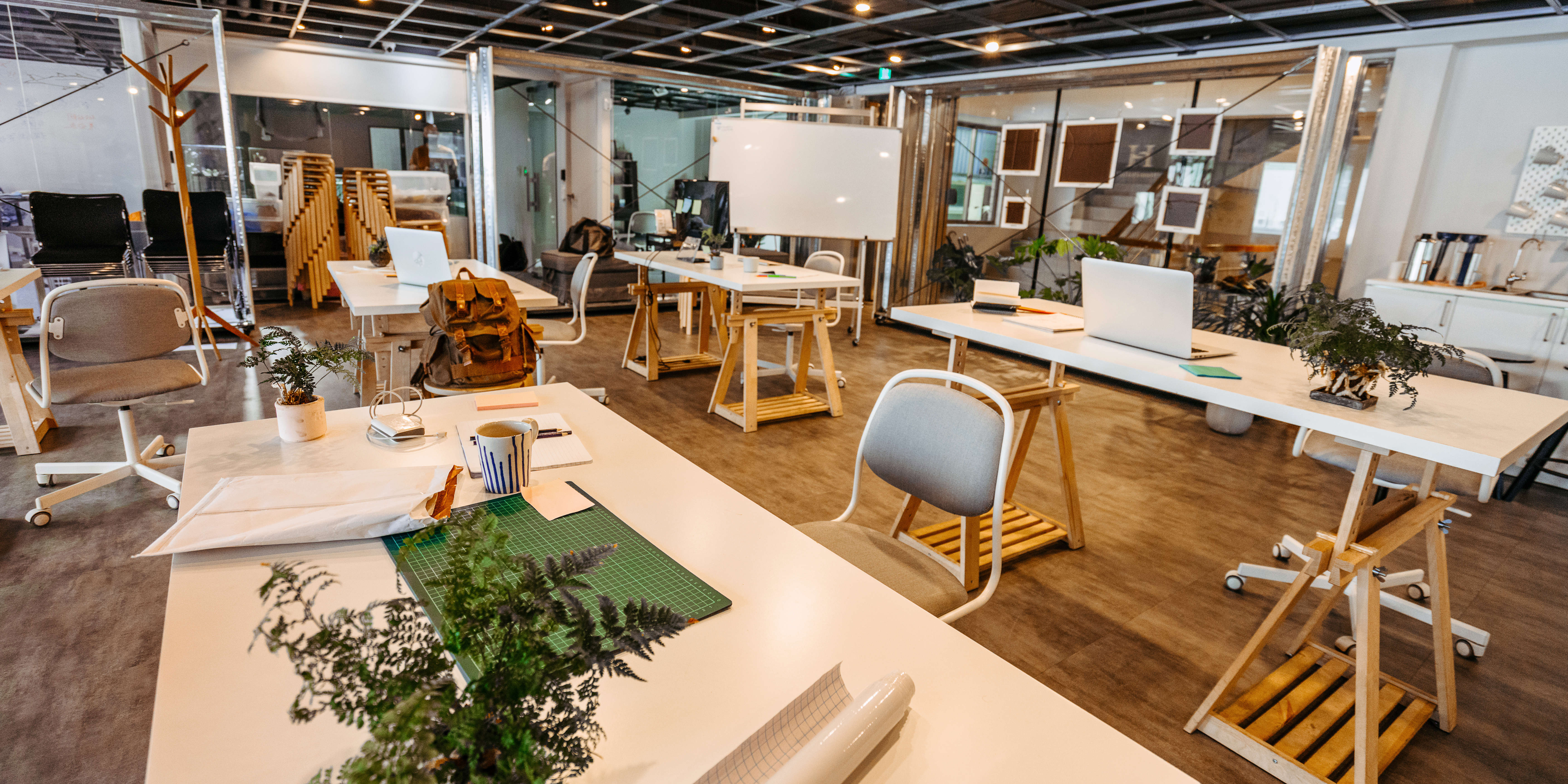As the dust settles on the tumultuous years following the onset of the pandemic, we’re witnessing a paradigm shift in office attendance patterns in major cities. Recent data from Kastle Systems, a leader in security technology, indicates a notable decline in office attendance. For the week ending January 17, 2024, big-city office attendance averaged just 46.3% of pre-pandemic levels, a slight decrease from 48.5% in the previous week. This dip represents a continuation of a trend observed throughout 2023, where office attendance struggled to surpass the 50% mark.

In the early weeks of 2024, Kastle Systems‘ “Back to Work Barometer,” which tracks anonymous keycard data from clients’ office properties across ten cities, painted a rather stark picture. The data showed that average attendance peaked at 51.6% of pre-pandemic levels in early December 2023 but has since remained below the 50% threshold. Notably, Austin, Texas, led the pack with 58.4% of pre-pandemic attendance, followed by Dallas, Houston, Los Angeles, and New York.
This shift in office attendance patterns poses significant challenges and opportunities for commercial developers and business owners. With a hybrid work model becoming the norm, the demand for traditional office spaces is evolving. To stay ahead in this changing landscape, it’s crucial for stakeholders to adapt and innovate.
Adapting to New Realities: Strategies for Commercial Developers
- Redefining Office Spaces: Modern workers seek flexibility and a blend of work and leisure. Developers should consider transforming traditional office spaces into multi-functional areas that cater to these needs. This can include shared spaces, wellness centers, and leisure zones.
- Investing in Technology: Upgrading office buildings with smart technology can enhance the attractiveness of these spaces. Features like touchless entry systems, advanced air filtration, and personalized lighting can make office environments more appealing and safer.
- Sustainable Developments: Sustainability is no longer a buzzword but a necessity. Eco-friendly buildings with green certifications are increasingly favored by tenants and can command higher rents.
- Flexible Leasing Models: In response to fluctuating demands, offering flexible leasing terms can attract a broader range of tenants, including startups and freelance professionals.
Opportunities for Business Owners
- Embracing Hybrid Work Models: Companies should acknowledge the shift towards hybrid working. This means fewer people in the office at any given time but also the need for effective remote working solutions.
- Optimizing Space Utilization: Businesses can reduce overheads by downsizing their office spaces or subleasing unused areas. This is not just a cost-saving measure but also a strategic realignment with current trends.
- Enhancing Employee Experience: For the days employees are in the office, making their experience as enriching as possible is key. This could involve creating collaborative spaces, investing in ergonomic furniture, and providing amenities that support well-being.
- Leveraging Data for Decision Making: Utilizing data analytics to understand employee preferences and space usage can lead to more informed decisions about office space needs and configurations.
Staying Ahead of the Curve
The commercial real estate market is undeniably undergoing a transformation. JLL‘s “Global occupier trends to watch in 2024” survey highlights that 45% of employees favor a hybrid work model. Similarly, CBRE‘s 2023 Real Estate Market Outlook underscores the importance of flexibility and technology in future office designs.
As we navigate these changes, the key for commercial developers and business owners lies in flexibility and innovation. It’s about reimagining spaces, embracing technology, and prioritizing sustainability and employee well-being. Those who can adeptly navigate this shift will not only survive but thrive in the evolving market.
In conclusion, the decline in office attendance is more than just a statistic; it’s a signal of changing times. For commercial developers and business owners, the path forward involves embracing these changes, understanding the new needs of tenants and employees, and being proactive in adapting to these evolving demands. By doing so, they can optimize ROI and maintain relevance in a market that continues to evolve post-pandemic.
Disclaimer: The information provided in this article is for general informational and educational purposes only and is not intended as financial, investment, legal, or tax advice. The content is provided “as is” without any representations or warranties, express or implied. Schwieters Capital and its affiliates do not guarantee the accuracy, completeness, or timeliness of this information and are not responsible for any errors or omissions or for the results obtained from the use of this information. All investments involve risks, including the potential loss of capital, and there is no guarantee that investment objectives will be achieved. The views and opinions expressed in this article are those of the author and do not necessarily reflect the official policy, position, or views of Schwieters Capital or its employees. Readers should consult with their own financial advisor and conduct their own research and due diligence before making any investment decisions. Past performance is not indicative of future results. Schwieters Capital does not endorse any specific investment strategies or financial products discussed in the article.


